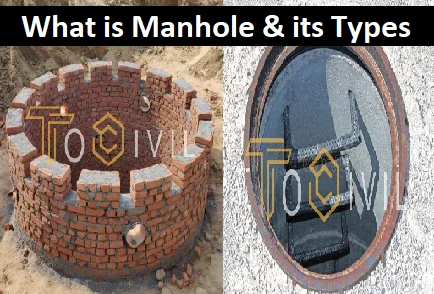Manhole
A unit built underground to provide access to utilities like a sewer system, drainage system, etc., is known as a manhole or inspection chamber. Thus, underground utilities are examined, altered, cleaned, and maintained with the help of a manhole.
What is a Manhole
- A man-hole is a hole or shaft in the ground used to access underground utilities like electrical equipment, sewers, or pipes.
- Man-holes are typically covered with a lid or cover to prevent unauthorized access and protect utility systems from external elements.
- They are commonly used for underground utilities’ maintenance, inspection, and repair.
- Man-holes is made of various materials, such as cast iron, concrete, or brick.
- They can be found in urban and suburban areas and are essential for properly functioning infrastructure systems.
Manhole Cover
A man-hole cover is a removable plate or lid that covers the opening of a manhole. The cover is made of durable materials such as cast iron, steel, or concrete and is designed to withstand heavy loads and traffic.
Man-hole covers prevent unauthorized access to the man-hole and protect the underground utilities from external elements. They are common in urban and suburban areas and essential to infrastructure systems. Man-hole covers may also have features such as locking mechanisms or decorative designs.
Man-hole covers come in different sizes, shapes, and designs to fit various types of man-holes and infrastructure systems. manhole cover size depends on the diameter of the man-hole opening. Here are some common man-hole cover sizes:
- 450mm x 600mm (18″ x 24″)
- 600mm x 600mm (24″ x 24″)
- 750mm x 750mm (30″ x 30″)
- 900mm x 900mm (36″ x 36″)
- 1000mm x 1000mm (40″ x 40″)
- 1200mm x 1200mm (48″ x 48″)
Manhole Cover Materials
Cast iron and concrete are the two most common materials used in the construction of man-hole covers. These two materials are also employed in the construction of man-holes. Both materials are long-lasting, heavy, and inexpensive. Man-hole covers are now made of fiberglass, plastic, and composite materials thanks to advances in technology.
The Cast Iron Man-hole Cover is made of grey cast iron. Because ductile cast iron has a higher strength, it is used for man=holes in high-traffic areas (such as airports). The grey cast iron used to make man-hole covers is a carbon and silicon alloy. Carbon gives the element strength and durability. When manganese is added to molten iron, ductile cast iron is formed.
Why are Manhole covers round
Manhole covers are typically round because a round cover is easier to manufacture, transport, and install than covers with other shapes. Additionally, a round cover cannot fall through the circular man-hole opening, which could happen with a square or rectangular cover if accidentally turned diagonally.
The round shape also allows the cover to be rolled rather than lifted. Making it easier to move and requiring less effort to install and remove. Round covers also distribute weight evenly, reducing the likelihood of damage to the cover or the surrounding area
Purpose of Manhole
A primary function is:
- To perform an inspection, clean the sewage line, and remove any obstructions.
- With the aid of a man-hole, sewers can be joined, pointed in a different direction, or aligned.
- The covers of these have perforations that allow the toxic gases to escape. As a result, it provides the underground sewage system with good ventilation.
- The sewer line can be laid in standard lengths with the aid of man-holes.
Characteristics of a Manhole
The chamber or ring and the Vertical Circular Pipe are the two main components of a man-hole. The depth and sizes of the vertical circular pipe vary. These pipes are utilized to access the system’s inspection joints.
Man-holes are typically placed 0.5m from the road’s curb lines. Most often, it is built so that it is outside of the traffic’s wheel path.
A man-hole’s cover serves as a plug to prevent unauthorized access to the man-hole. Man-hole covers come in various shapes, including circular, square, and rectangular. Precast concrete, composite materials, or any glass-reinforced plastic material are all acceptable options for the cover material.
Steps are used to create access through the man-hole provision. A step ladder is built if the man-hole’s depth is less than 1 m. A standard ladder is installed if the man-hole is deeper than 2.5 meters. Modern man-holes don’t require physical entry anymore.
Types of Manholes
The following are the three main manhole types, according to depth:
- Shallow Manhole
- Normal Manhole
- Deep Manhole
Shallow Manhole
The depth of a shallow man-hole ranges from 75 to 90 cm. These are typically built at the beginning of a branch sewer or in a low-traffic area. The shallow man-hole has a light cover known as the inspection chamber.
Normal Manhole
These are installed at the sewer line and have a heavy cover on top. It measures 150cm in depth. A typical man-hole is square in shape.
Normal man-holes are found in streets, sidewalks, parking lots etc. They are designed to provide access to underground utilities for maintenance and inspection. Normal man-holes may be used for sewage, storm water, water supply, gas, or electrical systems, depending on their location and purpose.
Deep Manhole
A deep manhole with a heavy cover at the top is available at a depth greater than 150 cm. The capacity for growth is greater, as is the ability to descend.
Materials Used to Build Manholes
According to the material, there are Five main types of man-holes:
- Plastic Manholes
- Precast Concrete Manholes
- Fiberglass Manholes
- Brick Manholes
- Metal Manholes
Plastic Manholes
The material polyethylene is used to create plastic man-holes. This was produced using a sturdy one-piece design. Seams and seals are not used in this construction because they raise a number of maintenance-related concerns.
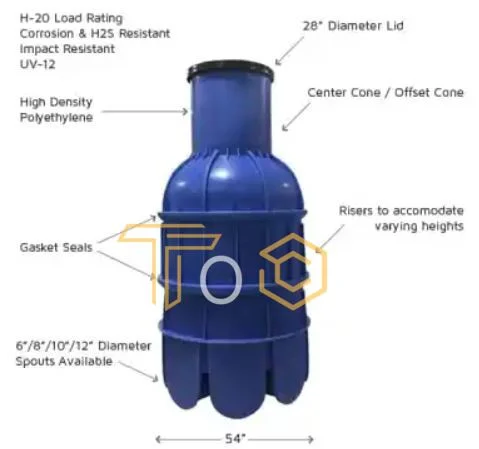
Man-holes made of plastic are sustainable and kind to the environment. They don’t contaminate the soil or the ground where they’re placed or have any negative effects.
Man-holes made of plastic are incredibly corrosion-resistant. These do not deteriorate over time and do not need frequent maintenance and rehabilitation. Ladders and man-hole covers are among the extras that come with these man-holes during manufacturing.
Precast Concrete Manholes
Precast concrete is a traditional method for building man-holes. These man-hole frames are constructed in a separate factory off-site. Thus, this technique guarantees quality and makes quick installation possible. On the job site, the manufactured precast man-holes are put together.
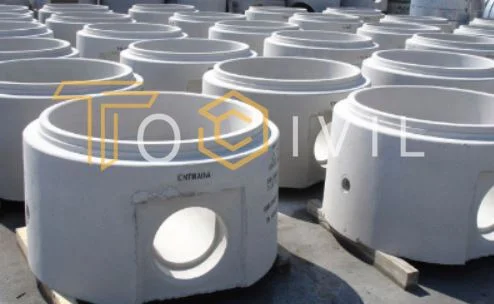
One of the factors contributing to its enduring popularity and widespread use is its increased durability, with a lifespan of 100 years.
Fiberglass Manholes
Man-hole barrels and covers are both included in the design of fiberglass manholes. Additional features, such as grinder channels, weirs, flumes, storm water separation units, etc., are incorporated into this fundamental structure.

It is a synthesis of various components. However, the fiberglass technology seals the units together so there are no seams or seals, and they behave as a single unit.
Fiberglass manholes are lightweight and simple, weighing only one-tenth as much as concrete man-holes. The man-hole is simple to install because the unit is lightweight. Manholes made of fiberglass are extremely durable and environmentally friendly.
Brick Manholes
Brick man-holes are underground structures used for accessing utilities such as sewers, pipelines, and conduits. They are typically constructed using bricks and mortar and are circular or rectangular in shape. Here are some details about brick man-holes:
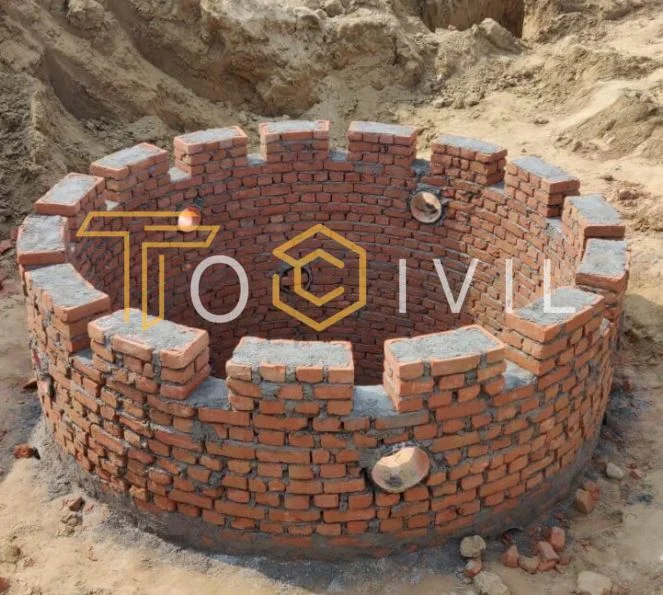
Construction: Brick manholes are constructed using high-quality bricks and mortar to form a sturdy structure. The bricks are stacked in courses to form the walls of the man-hole, which are typically reinforced with steel bars or mesh for added strength. The man-hole is then capped with a concrete or cast iron cover.
Durability: Brick manholes are known for their durability and can last for several decades if properly constructed and maintained. They are resistant to wear and tear, weathering, and corrosion.
Maintenance: Like other types of manholes, brick manholes require periodic maintenance to ensure they remain functional and safe. This includes inspecting the structure for cracks, leaks, and other damage and repairing or replacing any damaged components as needed.
Metal Manholes
Metal man-holes are underground structures used for accessing utilities such as sewers, pipelines, and conduits. They man-holes are constructed using metal materials such as cast iron, aluminium, or stainless steel. These man-holes are durable and resistant to wear and tear, weathering, and corrosion. Metal man-holes are typically constructed in sections and assembled on site to form a sturdy structure.
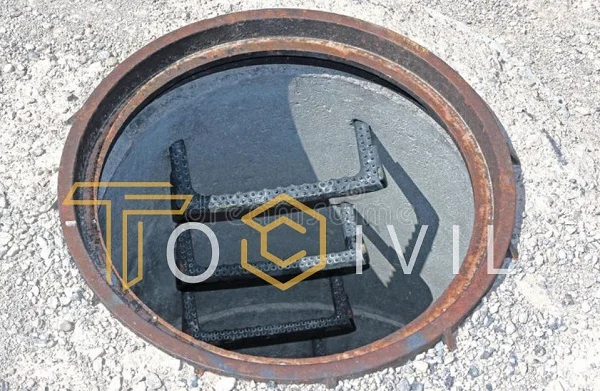
The man-hole components are cast or fabricated into sections and are capped with a metal cover. These man-holes require periodic maintenance to ensure they remain functional and safe. Overall, metal man-holes are a reliable and long-lasting option for providing access to underground utilities.
Maintenance and Inspection of Manholes
Maintenance and inspection of man-holes are crucial for ensuring their functionality, safety, and longevity. Here are some key aspects of man-hole maintenance and inspection:
Routine Inspection
Regular inspection of man-holes is important to identify any signs of deterioration or damage that may affect their structural integrity. This technique entails looking for cracks, leaks, corrosion, and other wear-and-tear indicators.
Cleaning and Repairing
Manholes should be cleaned regularly to prevent blockages and build-up of debris, which can lead to blockages and sewage backups.
Location of the Manhole
The following conditions apply to the man-hole construction:
- when a new sewer line is required
- The size and alignment of the sewer have changed.
- At least two sewer lines come together to form a junction.
Applications of Manholes
- Manholes will offer a secure route to the sewage conduits, which must occasionally be opened for maintenance and emergencies. By preventing water from building up, man-hole covers shield the roads from flooding during monsoon season.
- It fulfils a vital function because, during monsoons, the accumulated water will make the roads slick, making it difficult for people to walk or drive. Man-hole covers prevent accidental falls into the holes by people and animals.
- They stop the sewage tunnels from emitting unpleasant smells and dangerous gases that could seriously endanger people’s lives. Worldwide rds.’ demands.
- It is commonly used in telecommunications and fibber optic networks to provide access to cables and other components. They allow for easy maintenance and repairs to be performed on the web
- It is also used in electrical systems to access transformers, cables, and other components. They allow for easy maintenance and repairs to be performed on the system.
More Posts
FAQ’s
Difference between Manhole and Inspection chamber?
Man-holes are used for accessing large-diameter pipes and utilities, while inspection chambers are used for accessing smaller pipes and junctions. Man-holes are larger and deeper than inspection chambers and typically constructed using precast concrete or other materials. Inspection chambers are usually shallower and may be made of precast concrete or brick.
How to Remove a Manhole Cover?
Straighten your back and slightly bend your knees as you use the hook as a lever to lift the covering.
1. Use your legs to push down and pry up the lid.
2. inspect the area for any debris or damage and replace the cover properly.
3. Always wear appropriate safety equipment and call a professional if the cover is difficult to remove.
4. Never put your hands, feet, or anything else under a lid.
How Much does a Manhole Cover Weight?
A typical manhole cover weighs more than 250 pounds (113 kilograms). But in the United States, man-hole cover varies between 100 and 300 pounds (45 to 136 kilograms). Man-hole covers must balance being heavy enough not to be rattled or dislodged when busy traffic drives over them and being light sufficient that service workers can lift them with a man-hole hook.
